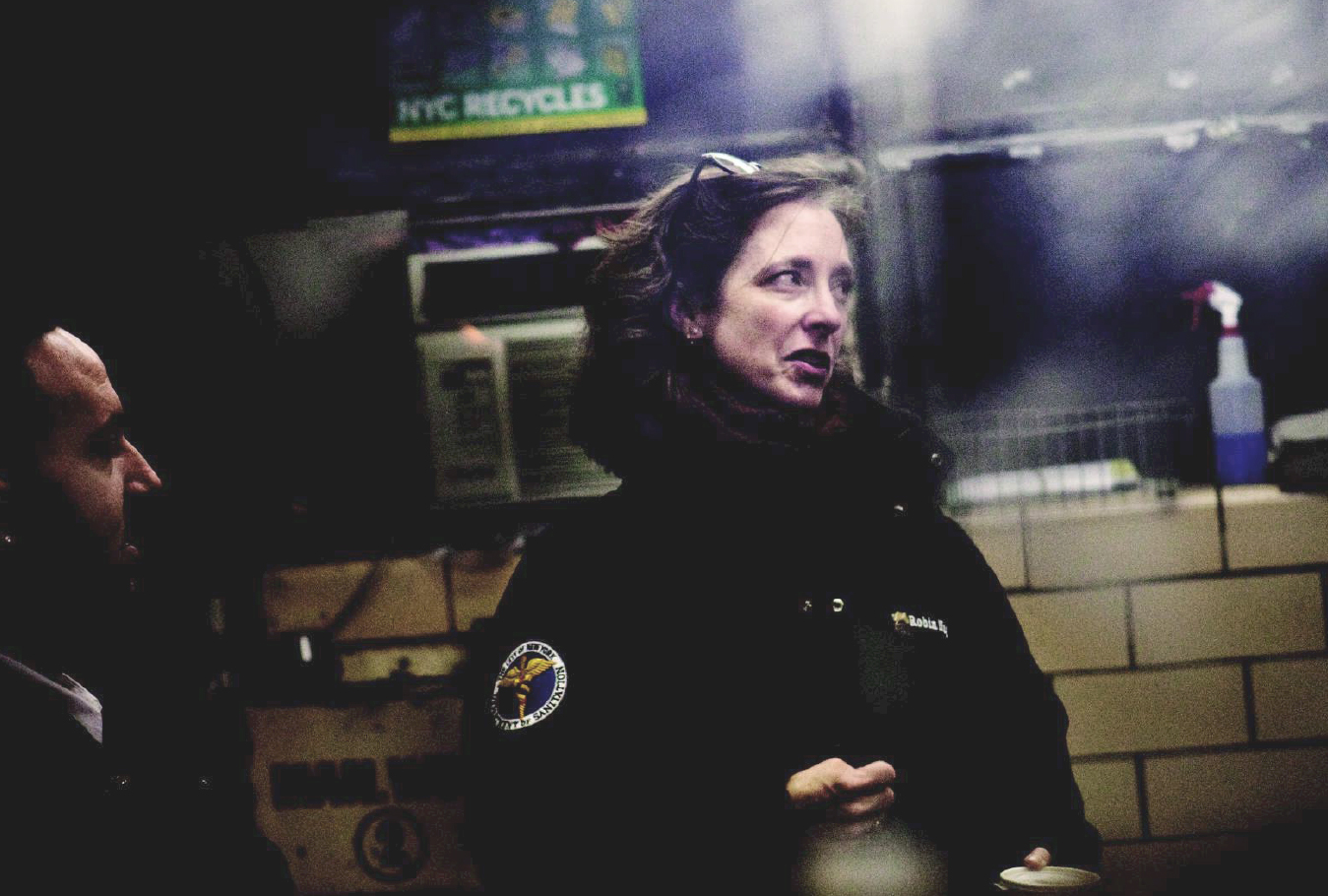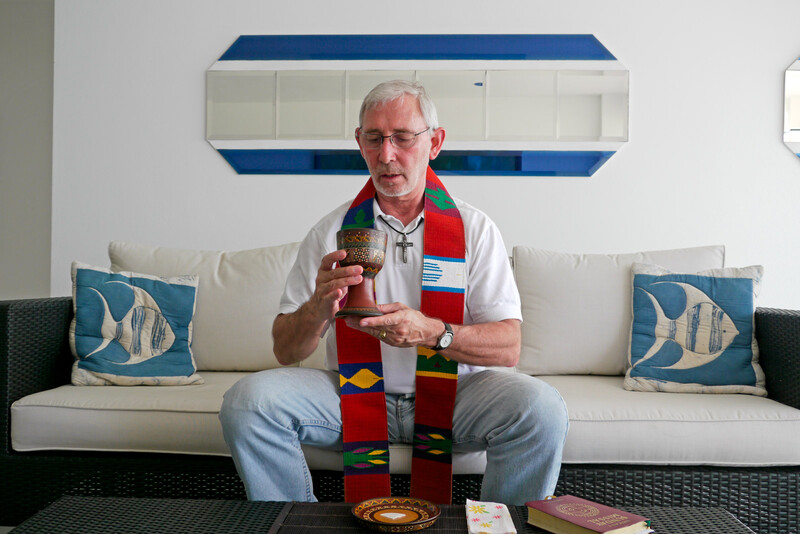
To contain Robin Nagle’s ardor for garbage in five pages of recyclable magazine print requires acts of consolidation worthy of the mashing hydraulics of New York City’s 2,030 white sanitation trucks, whose two-person crews collect about 11,000 tons of municipal waste each day (and nearly another 2,000 tons of recyclables), so let’s cut to the chase: Morningside Heights, 6:10 a.m., midwinter, 14° F. Blueberry darkness. Nagle ’94GSAS strides up Broadway with a hiker’s gait, wearing a spruce-green jacket on whose back is written, in white letters, DSNY ANTHROPOLOGIST. Her head is covered with a beet-red, cylindrical wool hat that she knit herself. She’s here at this hour to help us better understand an event so commonplace, so essential, so successful, that we notice it only when it fails to occur — which is just one form of waste-related invisibility that Nagle breaks down in her new book, Picking Up: On the Streets and Behind the Trucks with the Sanitation Workers of New York City, a compact volume jammed with observation sharp as the peeled-back license plates that cut workers’ calves as they move between curb and street, fragrant with a poetry of putrefaction (a garbage transfer station, with its mounds of rotting waste, is “nothing less than the juicy, pulsing, stench-soaked center of the universe”), colored with history and lingo and tough, gloves-on research.
“When people learn I was a uniformed New York City sanitation worker, they’re astonished,” Nagle says into the lunar freeze as she crosses West 111th. “If they found that out about you, they might or might not be astonished, but they’d be less so because you’re a boy. But in certain circles, there’d be people who’d say, ‘You did that work?’ Because you are supposed to fit into a different category of labor. And you are supposed to have different opportunities. And you are representative of that class that would never choose work that’s so physical and smelly. And ‘Oh, sanitation workers are’ — fill in the blank — ‘not bright, not ambitious, not capable.’ None of which is true.”
“Why do people think that?” we say.
Nagle pauses a long second. “I’m going to get wonky.”
“Please.”
“There are categories of labor that are focused on materials or functions that culturally we segregate. And we collapse those materials or functions with the people who have to deal with them. So if we disapprove of, or stigmatize, or don’t want to think about certain infrastructures and behind-the-scenes processes, we also disapprove of, stigmatize, or don’t want to think about the people responsible for those processes.”
“We don’t see them.”
“We learn not to see them.”
“Does guilt figure into this? We don’t see them because on some level we’re ashamed that they’re picking up our droppings, so to speak?”
“Yes. We do feel guilty, and we need a scapegoat, and sanitation workers are very convenient, because they’re out there every day. ‘I don’t like that pile of trash in front of my house, and they’re actually touching it and handling it, so they’re bad guys.’”
“And maybe I’m a bad guy for generating it. But that’s so buried, probably.”
“Buried, and also: ‘My little bag of trash is just such a little bitty piece in a big pile. I’m not responsible for that big pile.’”
One summer, when Nagle was ten, she went hiking in the Adirondacks with her father. As she walked through a green forest unspoiled by humanity, she happened upon a big pile: an unauthorized dump. The sight shocked her, and raised a few questions in her future-social-scientist’s brain. Where does garbage go? Who takes it there? Why do we make so much of it? In the early 2000s, while researching Picking Up, Nagle, by then a professor of anthropology at NYU, decided that to really understand the job she had to do the job. She took the test and was hired. After a few months, the difficulties of balancing two full-time jobs and a family caused her to resign, but she sought to stay connected. She remembered Mierle Laderman Ukeles, DSNY’s artist-in-residence since 1977, and came up with the idea of an anthropologist-in-residence, a nonpaying position that would allow her to continue her work with the department, which includes an oral-history project and plans for a sanitation museum. She has held the position since 2006.
Now, as she stomps up Broadway, Nagle glances down the side streets, where supers and porters have already lugged their buildings’ contributions to the curb. The sanitation trucks aren’t due until seven, but out on Broadway, the private carters — the green trucks — gobble pyramids of dark-bagged commercial waste. All this trash will leave the city. Since the closing of Staten Island’s Fresh Kills landfill, the world’s largest, in 2001, New York’s waste has been shipped at great cost in dollars and diesel emissions to New Jersey, Pennsylvania, Ohio, Virginia, South Carolina.
“We have to recalibrate how we live,” Nagle says. “And to do that, we have to understand as much as possible about all the systems — oh, a broom! There’s a broom!”
“Where?”
“See the blinking yellow lights? That’s a broom. Let’s go up there.”
Nagle walks briskly toward West 113th and those yellow lights, past still-shuttered shops and scraps of trash on the sidewalk that eluded capture. She picks up her thread.
“In order to recalibrate, we need to understand as best we can all the systems on which we rely to sustain this lifestyle. Garbage creation. Garbage collection. Garbage management. These are huge factors in climate change and environmental crises of all kinds. There’s been a lot of attention given to garbage as a problem to solve, but almost none given to the human beings who make the system of garbage management work. If we have a better grasp of what this is all about, then we can understand — perhaps — how to change it in a way that is effective and positive. OK, now that’s a broom. Let me tell you about the broom.”
The broom. A boxy white street-sweeping machine with a quirky aura of modesty and cleverness, like a Pixar character.
“Its nickname is the bumper car,” Nagle says. “You don’t drive a broom; you operate a broom. You sit in what I call the cockpit (nobody calls it that — they would think that’s nuts) and you have an array of dials and gauges around you for things like how much water you have, though when it’s this cold you’re not going to use water because it’ll freeze. But water suppresses dust beautifully, so when you’re sweeping it’s much more effective if you can spray water in front of you.”
Nagle, during her sanitation career, spent many a solitary hour in the cockpit.
“There are two of these round brushes on the side — they look like big pizza pans with bristles. They’re at an angle that is carefully calibrated. You control the speed and the force. There’s a real skill to operating a broom. It takes a while to learn. More accidents happen with the broom than the truck, because the broom operator is constantly monitoring her mirrors and her gauges as well as the street.” The broom sits idle, waiting for the parked cars in front of the NO PARKING signs to move. “Brooms have a narrow window of time in which they can legally go in and sweep,” Nagle says. “Cars still at the curb can get a ticket. But without an enforcement agent, a broom can’t make anyone move. The operator can honk but can’t write a ticket.” The broom swings into a space between cars, sweeps, maneuvers back out. “That’s called sniping.” Nagle’s voice rises in empathy. “That broom can’t wait. If it waits for everyone to clear, it’ll never finish this stretch before that narrow window is closed.”
It’s time to thaw out before the trucks come. Nagle goes into Nussbaum & Wu (blessedly open since six), orders tea, and sits at a table facing the glass doors so she can watch for a white truck. Two feet away stands a swing-lid trash bin with a paper plate stuck in its maw. Nagle sips from a paper cup. No absurdity is lost on her, even at this hour.
“We’re sitting here at a coffee shop with paper containers of tea and coffee,” she says. “I have a bagel wrapped in wax paper on a paper plate, with a paper napkin. I’m going to throw it all out when I’m done.” It almost sounds brazen. “But if I save it and recycle it and make sure that no piece of the leftover goes into the garbage, I’ve just done a good thing for the planet. Right?”
“Um —”
“No. It’s too small. If I went back to the factory that manufactured the paper and found a way to make sure that the production of this paper plate — the bleaching process that makes it white, the machines that make the crimping around the edge — was carbon-neutral and that it was a zero-waste plant, would that make a difference? To the planet?”
“Well —”
“No. Because it’s still too small. If you took every paper manufacturer in the US and they all calibrated to be zero-waste and carbon-neutral, would that make a difference to the planet?”
“Er —”
“In a tiny, tiny way, yes. But enough to begin to tilt the scales and really address climate change and the particulates in the air? Not yet.” According to the EPA, Nagle says, municipal solid waste accounts for 3 percent of the nation’s waste stream. The other 97 percent is mainly industrial, commercial, medical, manufacturing, agricultural, construction and demolition (C&D), and mining. That paper cup is a grain of sand. “When we talk about New York City generating 11,000 tons of garbage per day, that’s just household waste. C&D is approximately another 11,000 to 13,000 tons. So is commercial waste. That means New York City generates something close to 40,000 tons a day. Yet there’s a lot of attention and resources given to municipal curbside recycling, and it is important, but not as important as we teach. We tell children, ‘When you recycle that plastic bottle, you save the planet.’ Nonsense.”
Nagle pulls from her bag a ball of yarn the same red as her hat and begins knitting. She grew up in the Adirondack village of Saranac Lake and spins her own yarn. Once, while on collection on the Upper East Side, she found, by the curb, a bag of pure wool of the highest quality, over a hundred dollars’ worth. That was serious mongo. Picking Up’s glossary defines mongo as “(n.) objects plucked/rescued from the trash; (v.) to take objects from the trash.” It’s against DSNY regulations to mongo, Nagle says, but workers quietly indulge. Lamps, books, air purifiers, microwave-oven plates. “A bag tipped over, a ball of yarn fell out, and I understood why guys who mongo tell you, ‘The street gives you things that are yours.’” Nagle is open to cosmic suggestions. Primo yarn? How could she not mongo? “That would be like refusing a gift from the universe,” she says. “Which is rude.”
While Nagle is comfy on academic panels theorizing and psychologizing about consumption and disposal, Picking Up is told from the trenches. And it’s not just about the street: Nagle examines the “eye-crossing” paperwork of the DSNY bureaucracy and the folkways of a thoroughgoing male culture that was slow to warm to a female newbie professor. It wasn’t until 1986 that women were admitted to the ranks. Of today’s 7,000-strong force, about 220 are women. Nagle reports that gender attitudes have improved, at the expense of macho assumptions about what it takes to be one of New York’s Strongest. Still, she encountered locker-room skepticism of a woman’s ability to lift and heave bloated bags, operate trucks and mechanical brooms, endure extreme weather and rats and maggots (AKA “disco rice”) and the intense stink that, at its transfer- station apotheosis, attains, for Nagle, a kind of olfactory purity. “It’s easy to think of the smell as abhorrent,” she says, “but at the same time, you have to let go. It’s like the cold. Or the heat. At some point you have to stop fighting it.”
Gag-inducing odors, disco rice, bone-snapping cold — these are among the job’s gentler dispensations. The US Bureau of Labor Statistics places sanitation consistently among the top-ten most hazardous jobs. Picking Up enumerates the perils: projectiles shooting from the hopper (“bolts, nails and screws, plastic bottles, cans, shoes, mattress springs, wood fragments, glass shards”), noxious materials (“It would be difficult, if not impossible, to catalog all the toxins to which sanitation workers are exposed”), and, of course, traffic. More sanitation workers in the US are killed on the job per labor hour than police officers or firefighters — which makes one wonder why there isn’t, to Nagle’s knowledge, a municipal monument to sanitation workers. Nagle’s museum would address this deficit: it would educate visitors on the human side of sanitation and introduce them to figures like Colonel George E. Waring Jr., the engineer who, having designed Central Park’s drainage system and led the Fourth Missouri Cavalry in the Civil War, became, in 1895, New York’s Commissioner of Street Cleaning. (The Department of Street Cleaning, founded in 1881, is the forerunner of the DSNY.) Waring achieved what was generally considered to be impossible: he raised an army of broom-carrying, white-uniformed men (white to signify hygiene) and sent them into battle against a gigantic, waist-deep, vermin-crawling, disease-spawning enemy that festered in the reeking streets of a city plagued by yellow fever and cholera. Like no one before or since, Waring cleaned up this town. “San men were heroes,” says Nagle. “There were Broadway plays about them.” So what happened? “We got used to it being done well. We take it for granted that they’re out there every day. We don’t have to worry about it, because they’re out there.”
But one recent event — a historic storm last fall — brought sanitation workers more credit than they’d received since Colonel Waring’s men subdued the Five Points.
“Not only did Sandy slam the city and create instant debris,” says Nagle, “it hit neighborhoods where lots of sanitation people live. In many cases, the workers who responded in the Rockaways, Belle Harbor, Breezy Point, Staten Island, and Red Hook live in those places, and their own homes were destroyed. I don’t mean their basements flooded. I mean their homes were turned into kindling. But they couldn’t tend to that because they had to be on the frontlines twelve, thirteen, fourteen hours a day, seven days a week, for all those weeks, answering the city’s need to clean up.”
Nagle speaks with an emotional hitch of the WE ♥ DSNY signs painted on the sides of flooded houses, and of a news photo of President Obama shaking hands with a san man.
“The workers carried an extraordinary burden. And they got real kudos.”
Even so, invisibility remains the rule. Nagle connects our blindness to the death fear: trash as a reminder “that nothing lasts, not even ourselves.” Why wouldn’t we want to avoid everything about it?
“I was astonished how completely invisible I was, and how easy it was to become invisible,” Nagle says, knitting away. “You put on that sanitation-worker uniform and you will achieve invisibility. I did occasionally get looks going to or from my work site if I traveled in uniform, because I don’t fit the stereotype. But once I was working, in the truck or the broom, I was, at the most, an obstacle to be navigated by motorists. Walking on the street in uniform, or standing behind the truck, I’m like the weather. I’m just there. I will come and I will go. If things have been rescheduled for snow, my truck will get to my pickup a little later than usual, which is a variation in the pattern that, if anyone notices it at all, is just a blip. You’re almost an element of the city as foundational and unthoughtworthy as a stop sign or a fire hydrant. You’re like moving street furniture.”
“How did that feel?”
“Alarming. Bemusing. Liberating. I had a certain sense of freedom because I realized nobody gave a shit about who I was or what I was doing, so long as I didn’t get in their way and I was in and out of their block fast. There’s a truck.”
White elephant. Crossing Broadway, headed west. Nagle puts away her knitting, drops her trash in the bin, goes outside into the whip-cold morning, and turns the corner.
The street slopes down to Riverside Park, overlooking a sweep of the park’s bare trees, stark against pearly river and milk-blue sky. The truck is the groaning, hungry creature of a frigid dawn. It hugs the hill. The south side of the street is peaked with piles of dark bags. Two sanitation workers, male, clad in bright chlorophyll-green vests, work in silence: one tosses the heavy bags from the curb to the street, two at a time; the other lifts those and throws them into the hopper, then works the handles on the side to activate the compactor blade, which descends inexorably on the load. Bags burst. Pop! Pop! Pop-pop-pop! Mists exude from ruptured objects. The truck keeps gorging. “The specs are for a max load of roughly twelve tons, but you can squeeze fifteen if you have the right conditions,” Nagle says. “That requires water, which helps things squish together better.”
“A chair — a chair just went in there.”
“Sure,” says Nagle. “See the mirror? I’ve seen those shatter into a bajillion shards of gorgeous little flying knives.”
The mirror, a pristine, above-the-mantel heavyweight, is devoured without incident. The driver tosses more bags from curb to street.
Splat!
“OK, that bag broke,” says Nagle, “but its contents did not fly out in the street. When that happens, it’s called ‘spillage.’” The driver hops into the cab and backs up while his partner guides him with clear and simple hand signals. The two are in constant communication, little of it verbal. “People who have been doing this together for a long time don’t need to talk much,” Nagle says. “They know each other’s rhythms so well that it becomes a kind of choreography.” The truck stops, the driver gets out, and the men resume their dance: bags fly two by two, land, lift again, and plop into the hopper. In minutes, with deceptive speed, the duo has conquered the block.
The truck rounds the corner at Riverside. Nagle, at the crest of the hill, watches it disappear.


